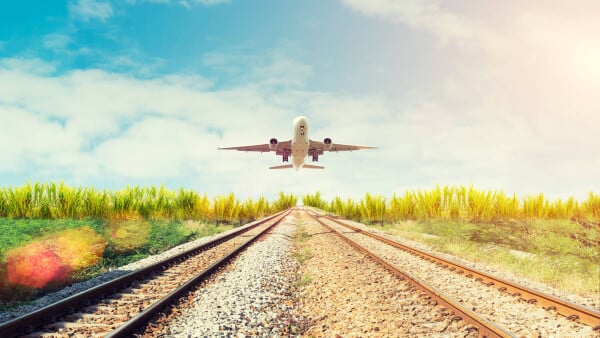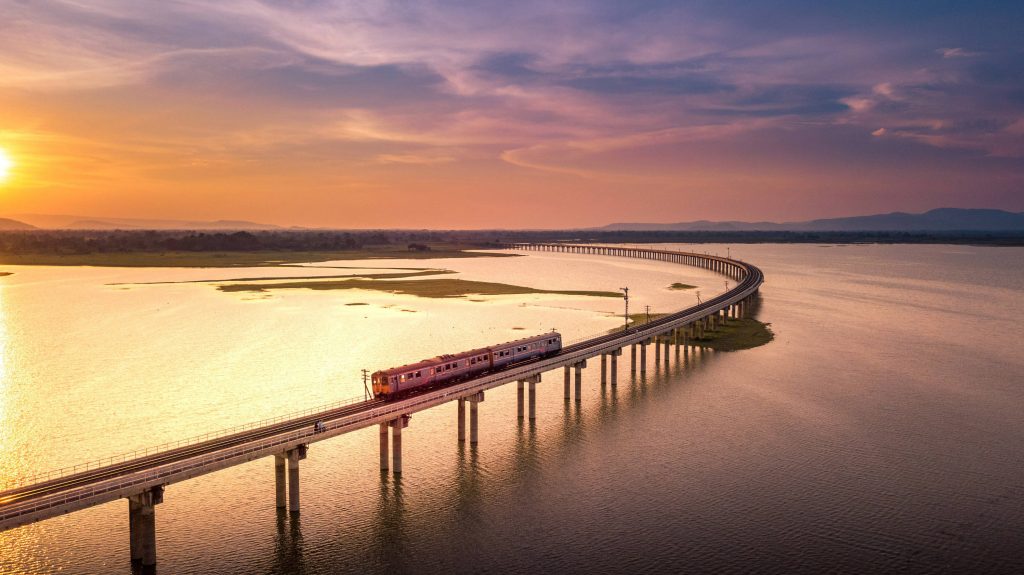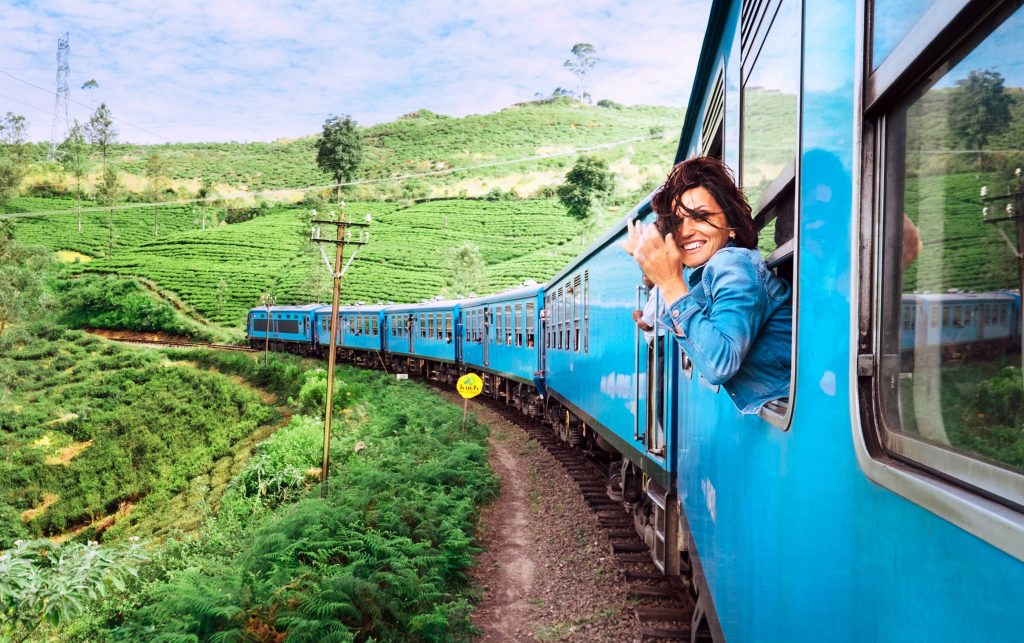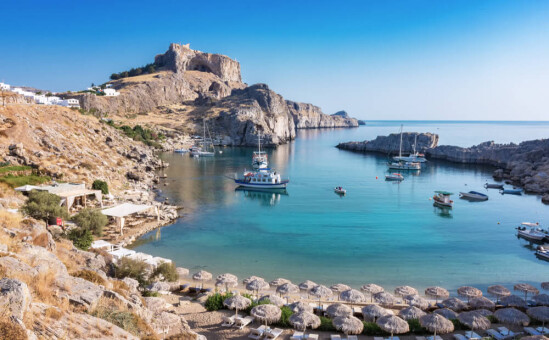The environmental impact of taking a train vs. flying
The world is too big and beautiful for us to stop traveling and exploring everything it has to offer, so discover how to become a more sustainable traveler.

The world is facing a climate crisis. And as it turns out, tourism is responsible for approximately 8% of global greenhouse gas emissions (GHGs) each year, which makes it a very difficult battle to win as people will not cease exploring the world. There is a silver lining, however, as technology is successfully reducing the emissions of aspects of tourism and travel. Still, the growth in the number of people traveling continues to outstrip the pace of these improvements.
Fear not, there are steps we can all take to begin to reverse this trend.
The world is too big and too beautiful for us to stop traveling and exploring everything it has to offer! We want to help you become more aware of your personal environmental impact and we believe that with access to the right information, we can all become more sustainable travelers.
What’s the most environmentally friendly way to travel?
This is quite a complex question to answer! Distance traveled, type of fuel used and occupancy of the vehicle all impact the “per passenger mile” carbon footprint.
The most polluting type of transport is short-haul flights of less than 300 miles. Because fuel consumption is highest during takeoff and landing, short-haul flights produce more emissions per mile traveled. This form of transport creates the most carbon emissions per passenger mile of any form of transport. Planes also emit GHG emissions directly into the earth’s upper atmosphere as scientists believe this multiplies planes’ environmental impact. In a report from 2008, The US Environmental Protection Agency concluded that train and plane per passenger mile emissions become comparable when a journey is over 700 miles long. This means that the 500 miles distance from Hanoi to Hoi An, for example, will cause less environmental damage if you travel by train instead of flying.
When comparing the carbon footprint of air travel with train travel, it is also important to consider the type of trains used in each country. In Europe, taking the train from London to Paris emits 90% less carbon dioxide than a short-haul flight. In Southeast Asia, this is a lot harder to estimate. Trains are often older and don’t use the latest technology to reduce their carbon footprint. In this region, the savings of taking the train won’t be as high as 90%, but you can still significantly save the environment by taking the train instead of a flight when traveling shorter distances.

As a general rule, “high capacity,” land-based modes of transport have the lowest carbon footprint for distances of less than 1,127 km (700 miles) (i.e. vehicles such as trains, buses or trams are generally the least harmful.)
The fun and adventure of train travel
Particularly in Vietnam and Thailand, it is possible to travel to many of the most popular destinations by train. It’s not just the environmental benefits that make train travel a great option when planning a trip, it’s also about reducing your personal carbon footprint.
1. Traveling by train can be a great time-saver
Flying may be the quickest way to get from A to B on paper. But have you considered traveling to the airport, checking in and dropping your bag, and waiting for your (inevitably delayed) flight?

Unlike airports, train stations tend to be in the city center and are much easier to access. Plus, you can avoid the extra costs of checking in luggage when traveling by train.
And a bonus: you might find yourself sharing your cabin with friendly locals! It’s all part of the travel experience.
2. Traveling overnight is the perfect solution to not waste your valuable day time
Train companies usually operate both day and overnight services. You can book seats or a sleeper berth in advance to guarantee a spot in a carriage with air conditioning.
Imagine, if you travel by train, you can fall asleep in the madness of Hanoi and wake up surrounded by Sapa’s beautiful rice terraces the next morning. This journey from Hanoi to Sapa is one of my personal favorite routes to travel by train in Southeast Asia!
3. Save on costs on accommodation by taking a night train
Traveling by train overnight has the added benefit of providing you with a bed, thus avoiding having to pay for a hostel.

Sure, you might not have the smoothest night’s sleep of your life. But perhaps being woken by the creaks of a train carriage is preferable to unexpected turbulence at 38,000 feet!
4. Ticket prices are more consistent than flight tickets
We all know how frustrating it is when you want to book a flight and find that the prices are significantly higher than they were when you checked yesterday.
One big advantage of train travel in Southeast Asia is that ticket prices are consistent on each route, no matter which day of the week you travel. The only thing you have to worry about is that you book your seat before it gets sold out.
5. Enjoy the beautiful scenery while looking out the window
For us, the real advantage of traveling by train is that you can sit back, relax and enjoy the scenery. It won’t be long before you leave behind the town or city and are surrounded by beautiful natural landscapes.

The train journey between Da Nang and Hué, for instance, passes through thick jungle vegetation as well as along the beautiful coastline of central Vietnam. If you book a late afternoon train, you can enjoy spectacular views of the sun setting over remote fishing villages from the comfort of your train carriage.
One extra benefit you may not have thought about
Investments in railways are an important step forward in reducing our carbon footprint. Expansion of railway networks can, therefore, help reduce our global carbon footprint. Growth in railway passenger numbers is especially high in India and Southeast Asia, where the International Union of Railways predicts a seven-fold increase in railway passengers by 2050. The more people who opt to travel by train, the more companies and governments are incentivized to invest in the modernization of trains and expanding rail networks.
In Thailand for example, the transportation sector currently contributes around 20% to the country’s total GHG emissions. To minimize the carbon footprint, the government plans to expand the train and metro rail connectivity across the Bangkok metropolitan region. Moreover, a new high-speed railway to be opened in 2025 will connect 3 major airports; Don Mueang and Suvarnabhumi airports in Bangkok as well as the international airport in Pattaya (U-Tapao), located about 170km from Bangkok. These advancements will not only solve Bangkok’s huge traffic jams but also make the train a better alternative to travel from the airport to Bangkok.
As travelers, we have the opportunity to influence the type of transport that receives our investment. When we choose to travel by train as opposed to taking a short-haul flight, we encourage countries to invest further in rail infrastructure. Travelers, locals, and the environment will all benefit from this in the long run.
FAQ
Yep. They produce the most emissions per passenger mile, especially if you are a solo traveler.
You don’t have to, but sitting on a hard wooden seat for 12 hours isn’t any fun. Better to splurge a little and get some sleep so you can arrive fresh.
Absolutely. If everyone did their part, imagine how much progress we could make.






